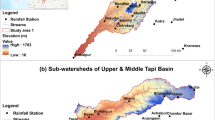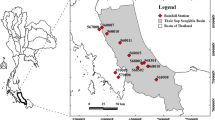Abstract
Missing data in daily rainfall records are very common in water engineering practice. However, they must be replaced by proper estimates to be reliably used in hydrologic models. Presented herein is an effort to develop a new spatial daily rainfall model that is specifically intended to fill in gaps in a daily rainfall dataset. The proposed model is different from a convectional daily rainfall generation scheme in that it takes advantage of concurrent measurements at the nearby sites to increase the accuracy of estimation. The model is based on a two-step approach to handle the occurrence and the amount of daily rainfalls separately. This study tested four neural network classifiers for a rainfall occurrence processor, and two regression techniques for a rainfall amount processor. The test results revealed that a probabilistic neural network approach is preferred for determining the occurrence of daily rainfalls, and a stepwise regression with a log-transformation is recommended for estimating daily rainfall amounts.




Similar content being viewed by others
References
Batista G, Monard MC (2003) An analysis of four missing data treatment methods for supervised learning. Appl Artif Intell 17(5–6):519–533
Cooley WW, Lohnes PR (1971) Multivariate data analysis. Wiley, New York, pp 364
Dempster AP, Laird NM, Rubin DB (1977) Maximum likelihood estimation from incomplete data via the EM algorithm (with discussion). J R Stat Soc Ser B (Stat Methodol) 39:1–38
Demuth H, Beale M (2000) Neural network toolbox: for use with MATLAB, version 4. The Math Works, MA, pp 846
Duda RO, Hart PE, Stork DG (2000) Pattern classification. Wiley, New York, pp 654
Hamilton LC (1992) Regression with graphics: a second course in applied statistics. Duxbury Press, California, pp 363
Heymsfield GM, Caylor IJ, Shepherd JM, Olson WS, Bidwell SW, Boncyk WC, Ameen S (1996) Structure of Florida thunderstorms using high-altitude aircraft radiometer and radar observations. J Appl Meteorol 35:1736–1762
Lal AMW (2001) Modification of canal flow due to stream-aquifer interaction. J Hydraul Eng 127(7):567–576
Levizzani V, Amorati R, Meneguzzo F (2002) A review of satellite-based rainfall estimation methods. European Commission Project MUSIC Report (EVK1-CT-2000–00058), Bologna, Italy
Maier HR, Dandy GC (2000) Neural networks for the prediction and forecasting of water resources variables; a review of modeling issues and applications. Environ Modell Softw 15:101–124
Makhuvha T, Pegram G, Sparks R, Zucchini W (1997) Patching rainfall data using regression methods. 1. Best subset selection, EM and Pseudo-EM methods: theory. J Hydrol 198:308–318
National Research Council (2003) Satellite observations of the Earth’s environment: accelerating the transition of research to operations. The National Academies Press, Washington, DC
Pegram G (1997) Patching rainfall data using regression methods. 3. Grouping, patching and outlier detection. J Hydrol 198:319–334
Roldán J, Woolhiser DA (1982) Stochastic daily precipitation models: 1. A comparison of occurrence processes. Water Resour Res 18(5):1451–1459
Schneider T (2001) Analysis of incomplete climate data: estimating of mean values and covariance matrices and imputation of missing values. J Clim 14:853–871
SFWMD (1999) A primer to the South Florida water management model (Version 3.5). SFWMD, West Palm Beach
Srikanthan R, Harrold TI, Sharma A, McMahon TA (2005) Comparison of two approaches for generation of daily rainfall data. Stochas Environ Res Risk Assess 19:215–226
Tarboton KC, Neidrauer CJ, Santee ER, Needle JC (1999) Regional hydrologic modeling for planning the management of South Florida’s water resources through 2050. In: Paper presented at 1999 annual international meeting, ASAE/CSAE, Toronto, Canada, 19–21 July
Wheater HS, Chandler RE, Onof CJ, Isham VS, Bellone E, Yang C, Lekkas D, Lourmas G, Segond ML (2005) Spatial-temporal rainfall modeling for flood risk estimation. Stochas Environ Res Risk Assess 19:403–416
Wilks DS (1995) Statistical methods in the atmospheric sciences: an introduction. Academic Press, San Diego, pp 467
Wilks DS (1998) Multisite generation of a daily stochastic precipitation generation model. J Hydrol 210:178–191
Acknowledgments
This study was supported by the grants from the Everglades Research Fellowship (ERF) Program at University of Florida, which was funded by the Everglades National Park, USA. However, the views expressed in this article do not necessarily represent the views of the agencies. The authors would like to thank Dr. Upmanu Lall at Columbia University and anonymous reviewers for their thoughtful reviewing of the manuscript and constructive comments.
Author information
Authors and Affiliations
Corresponding author
Rights and permissions
About this article
Cite this article
Kim, TW., Ahn, H. Spatial rainfall model using a pattern classifier for estimating missing daily rainfall data. Stoch Environ Res Risk Assess 23, 367–376 (2009). https://doi.org/10.1007/s00477-008-0223-9
Published:
Issue Date:
DOI: https://doi.org/10.1007/s00477-008-0223-9




